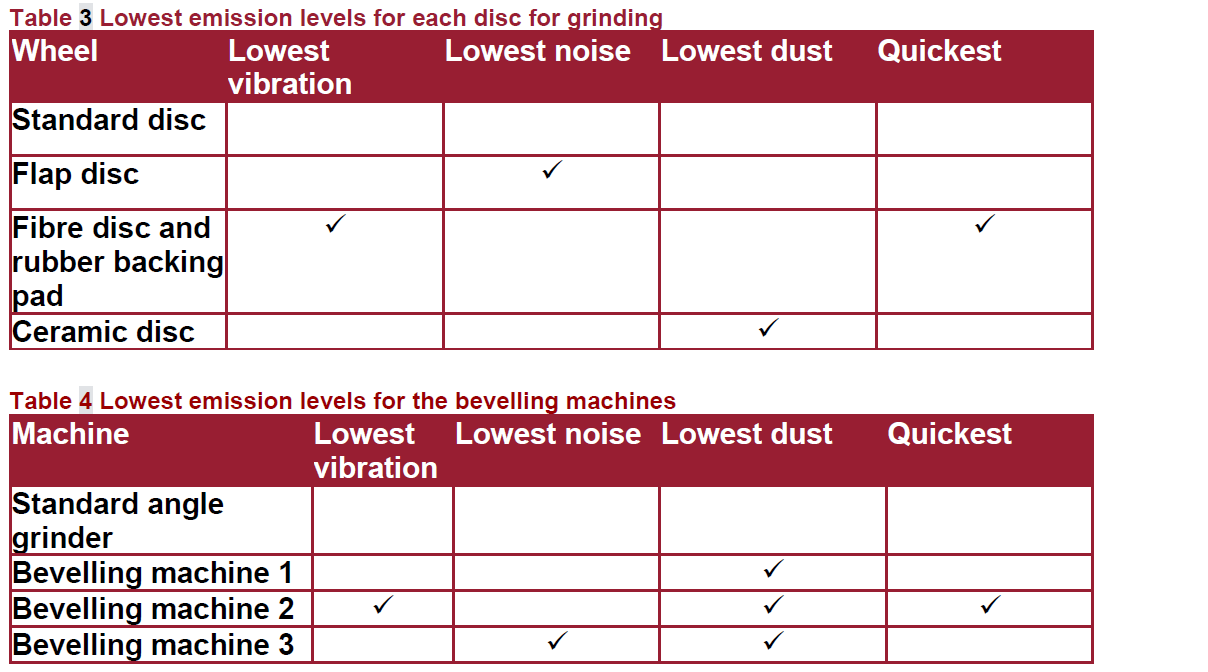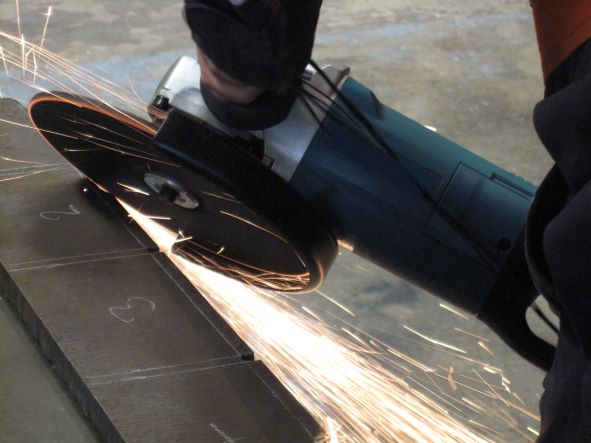Introduction
Hand-held angle grinders are widely used across a number of sectors, including steel frame fabrication.
Real-use Hand-Arm Vibration (HAV) measurements on angle grinders show upper quartile values in the range 7 – 9 m/s² (HSE L1401). This means that there can be a risk of ill health for operators regularly using these machines for more than 20 – 40 minutes per day. A high number of HAV syndrome incidents in the steel frame fabrication sector are reported and investigated under RIDDOR (Reporting of Injuries, Diseases and Dangerous Occurrences Regulations 2013).
Grinders typically produce noise levels of around LAeq 90 – 95 dB(A), so are significant contributors to occupational noise exposure.
In addition to HAV and noise, many power tool users are also exposed to other physical hazards including dust. Methods used to control dust, such as the use of water suppression systems, do not contribute to mitigating the effects of HAV or noise.
The most effective way of controlling exposures from grinders is to reduce or eliminate the use of these machines. HSE researchers have undertaken a project which has investigated alternative processes to grinding as well as methods designed to reduce emissions from grinders. The techniques investigated may also result in reducing some of the other safety risks that are associated with using these machines, such as lacerations, eye damage, amputation of fingers and fire risks due to the ejection of hot debris during metal grinding.
Method
A selection of angle grinders, attachments and wheels were identified that could potentially reduce vibration, noise and dust for three activities where grinders are commonly used. The activities were: grinding, bevelling and cutting. Specialist machines were identified for bevelling and cutting (bevelling machines and rebar cutters respectively). In addition, two angle grinders were tested: an angle grinder with a built-in auto-balancer and a standard angle grinder with anti-vibration handles. For each task, each combination of wheel and machine were repeated 5 times with vibration, noise and dust measurements made simultaneously. The wheels tested were:
- Standard grinding wheels
- Flap discs
- Ceramic discs
- Fibre discs used with a rubber backing pad
- Standard cutting discs
- Diamond discs
- Carbon discs
All products tested were commercially available for purchase or hire in 2020.
Findings
For all tasks there are alternatives that could reduce exposure to vibration, noise and dust when compared to standard wheels and angle grinders. The tests on the specialist machines showed that although they may produce higher levels of HAV, they can significantly reduce the time taken to complete the task, and therefore reduce the exposure overall. For example, although the bevelling machines tested produced nearly twice the vibration level, they completed the task in a tenth of the time.
For the grinding task, it was found that the fibre disc and rubber backing pad produced the lowest vibration and completed the task in the quickest time. The operator commented that this wheel and backing pad felt very smooth to work with and produced a very good finish. The flap disc produced the lowest noise, however the operator commented that a flap disc is not ideal for grinding off welds and instead would be used to finish. The ceramic disc produced the lowest amount of dust. When the standard angle grinder was used with anti-vibration handles it was shown to consistently reduce the vibration regardless of the wheel used.
For bevelling, the three bevelling machines were more efficient than a standard angle grinder and produced lower levels of noise, vibration and dust. The bevelling machines produced negligible amounts of dust due to the nibbling action of the machine on the metal rather than a grinding action. However, the operator commented that due to the high cost of the bevelling machines he would not purchase one unless his only job was to put bevels on sheets of metal.
For cutting, the lowest levels of vibration and dust were produced when using a diamond disc. However, this disc was inefficient at completing the task and in some cases did not cut the whole way through the rebar in the measurement period. The lowest noise and the quickest time were measured when using the carbon disc. An alternative machine to the angle grinder for cutting is a rebar cutter and this was shown to produce the lowest levels in all emission categories. The rebar cutter did not produce any measurable dust due to its compression action and the operator commented they could not feel any vibration through the handles. Tables 1 and 2 show a comparison of costs between all consumables and tools tested. Overall emission comparisons can be seen by activity in Tables 3 to 5.

Overall emission levels
Overall lowest emission devices for each activity are shown in Table 3 for grinding, Table 4 for bevelling and Table 5 for cutting.


Conclusions
When undertaking risk assessments for this type of work, the priority should always be eliminating the risk altogether, but this project has proven that alternative machines to angle grinders can reduce exposure to HAVs, noise and dust and should be considered. It is also important that duty-holders take a holistic view when looking at emissions and consider the overall reductions that can be made.
HSE guidance on noise and HAV (L1082 and L1401) is highly relevant for duty-holders on tool selection. It is important for duty-holders to identify efficient machines for the job, avoiding any high noise or vibration models and then manage the remaining noise or vibration risk.
References
- Health and Safety Executive (2019), Hand-arm vibration. The Control of Vibration at Work Regulations 2005, Publication L140
- Health and Safety Executive (2021), Controlling Noise at Work 2005, Publication L108
This publication and the work it describes were funded by the Health and Safety Executive (HSE). Its contents, including any opinions and/or conclusions expressed, are those of the authors alone and do not necessarily reflect HSE policy.


Recent Comments